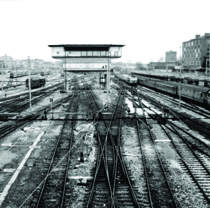Railway Station Role in Composing Urban Conflicts
Abstract
Despite railway infrastructure was the structural framework on which modern European States were developed, contributing to unify territories and to the establishment of Nations, right from the beginning, the relationship between railway and city has been characterized by physical, functional and social conflicts, mainly because of a lack of integration between infrastructural and urban policies, which have been produced strong conflicts during decades. These critical situations have concentrated on the railway stations surrounding areas, which have started symbolizing the main conflicts that are taking place inside the cities.
Similarly to what happened in the XIX century, today railway is a strategic infrastructure for the European territory development, thanks to the introduction of high speed transport systems and the promotion of rail transport as a more sustainable transportation system, which can quickly connect metropolitan central areas, more and more impenetrable by private vehicles, and key functions centres for the contemporary urban systems.
In this framework, railway stations are becoming public places representing a complex society which is more and more dedicated to motion; thus they offer an unmissable chance not only to carry out urban development and spatial cohesion policies, but also to compose old tensions caused by the sharing of physical space, which is more and more scarce and valuable, and by ghettoization phenomena which have been produced at local scale, between rail infrastructure and the surrounding urban context. Today, such conflicts are growing and they are involving many actors who express a lot of different interests, needs and expectations, relating to the station areas’ destiny.
Starting from the analysis of some conflicting situations between rail stations and the surrounding areas which have took place until today, this paper investigates some recent renewal interventions on Italian and European main railway nodes, their complex dynamics and the role of the most important players involved in these developments.
Contemporary main rail stations are addressed as complex systems operating in a condition characterized by a dynamic balance among the different elements which form them; the interpretation of their polysemic nature allows to identify the most suitable design procedures and intervention strategies to make stations the privileged places where to compose the conflicts between contemporary city and railway. Therefore, the purpose of this paper is to identify and to analyze crucial issues in order to build new liveable and effective developments. They refer, for instance, to the rail station configuration in order to be at the same time an efficient interchange transportation node and a meaningful and multifunctional city centre, but also to the detection of the most suitable tools and procedures to drive the urban and infrastructural transformations and to the proper involvement in the decision process of the different stakeholders who could be interested in these urban changes.
Downloads
References
Maffeo S. (2011) “L’Italia unita... dalle infrastrutture”, TeMA, 01-11, 51-60
Maggi S. (2001) Politica ed economia dei trasporti (secoli XIX-XX). Una storia della modernizzazione italiana, il Mulino, Bologna
Marris P., Rein M. (1967) Dilemmas of social reform: poverty and community action in the United States, Routledge & K. Paul, London
Moretti A., Pucci P. (1995) “Progetti di interconnessione” Urbanistica, 109, 26-35
Natalicchio S. (2001) “La riqualificazione dei centri di interscambio: una metodologia di classificazione delle stazioni ferroviarie, finalizzata alla localizzazione di funzioni. Il caso delle stazioni della linea Milano-Brescia” Atti della VIII Conferenza Internazionale Vivere e Camminare in città. Pianificazione urbanistica e progetto di infrastrutture per la sicurezza e la qualità nella mobilità pedonale, Università degli Studi di Brescia, Dipartimento di Ingegneria Civile - COST-UCE, Brescia 13-14 - 15 giugno
Pini D., Ventura N. (1985) “Piano, trasporti, città e ferrovia” Urbanistica, 78, 17-26
Pucci P. (1996) I nodi infrastrutturali: luoghi e non luoghi metropolitani, FrancoAngeli, Milano
Ventura N. (1993) “Stazioni ferroviarie per la città di oggi” Casabella, 606, 18-25
Ventura P. (2004) Città e stazione ferroviaria, Firenze Universitiy Press, Firenze
Viola F. (2004) Ferrovie in città: luoghi e architetture nel progetto urbano, Officina, Roma

Copyright (c) 2014 Tema. Journal of Land Use, Mobility and Environment

This work is licensed under a Creative Commons Attribution 4.0 International License.
Authors who publish in this journal agree to the following:
1. Authors retain the rights to their work and give in to the journal the right of first publication of the work simultaneously licensed under a Creative Commons License - Attribution that allows others to share the work indicating the authorship and the initial publication in this journal.
2. Authors can adhere to other agreements of non-exclusive license for the distribution of the published version of the work (ex. To deposit it in an institutional repository or to publish it in a monography), provided to indicate that the document was first published in this journal.
3. Authors can distribute their work online (ex. In institutional repositories or in their website) prior to and during the submission process, as it can lead to productive exchanges and it can increase the quotations of the published work (See The Effect of Open Access)
